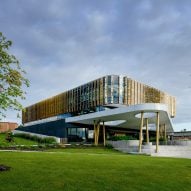Architecture studio Sam Jacob Studio has renovated a 1960s building at the University of Kent in Canterbury, England, using playful architectural references and bright colours to add layers of “wit and joy” to the existing interiors.
The project provides teaching spaces for the university’s School of Architecture, Design and Planning, part of the William Holford-designed campus that opened in 1965.
Sam Jacob Studio (SJS) sought to retain what it described as the “soft brutalist” character of the brick and concrete Marlowe Building when reorganizing the existing interior.
The Marlow Building originally housed the university’s physics department, which had a series of cellular offices on the ground floor and a top-lit laboratory space.


After detailed consultations with faculty and students, Jacob and his team determined a strategy that balanced areas for specific year groups and subjects with the ability to transform and open up spaces.
The SJS team said it was interested in “what happens between the logic of architecture and the coincidence of creative work.”
They based their design on a variety of famous creative spaces including the Bauhaus, Paul Rudolph’s brutalist Yale Art and Architecture Building, and Andy Warhol’s Factory in New York City.


The architects stripped away the existing interior to expose the concrete ceiling along with the building structure and services, which were kept as a backdrop for a series of minimalist interventions aimed at realising the new role of the space.
“This is a project that reveals the intrinsic qualities of the 1960s building, while also contrasting with the more fluid contemporary character,” the studio said.
“It is an architecture that invites inhabitation rather than imposing order, and that recognizes character, intelligence and joy as part of the essential role of architecture.”


SJS worked as much as possible with the existing spatial layout, adding only one wall on the ground floor and two on the first floor so that the interiors could evolve to meet different future requirements.
Instead of the walls acting as fixed partitions only, they are activated by the incorporation of movable components that can be used to adapt the layout of the studios.
Large sliding doors with polycarbonate openings allow some spaces to be separated, while pivoting wall sections can be opened or closed depending on the desired design.


Cannon Design draws on Michigan’s forested essence in university building design
The partition walls feature full-length wood panels to display artwork. These surfaces are given a more dynamic look by cutting the panels diagonally from corner to corner.
The standard height panels are topped with a shelf, where adjustable lights are mounted to allow illumination of students’ work. Mirrored panels above the shelf create the illusion of a continuous space.


The studio can be further customised to suit different working situations by rearranging independent elements including drawing boards, easels, monitors and movable storage units built using standard warehouse shelving.
Existing furniture was reused wherever possible, while doors salvaged during the furniture removal process were converted into desks, with pieces of yellow sheet metal added to fill in the holes where locks and vision panels once were.


The interior design includes many clear architectural references, according to SJS, including a color palette based on a paint system created by Le Corbusier in 1959.
“A series of columns used to mark the thresholds act as 1:1 models of Canterbury Cathedral, Brancusi, and James Stirling, like a library of the other architecture that populates the school,” the team explained.
To prevent the sun from heating the studios, a series of colourful curtains were added along with movable perforated panels that help control privacy. This creates a changing topography that brings life to the building’s exterior.


Sam Jacob founded his studio in 2014, having previously worked as part of the radical architecture group FAT for over 20 years.
SJS’s previous projects include a new entrance to the V&A Museum in London made from hundreds of glass tubes and a brightly colored studio and office for designer Yinka Ilori.
Photography by Timothy Soar.

